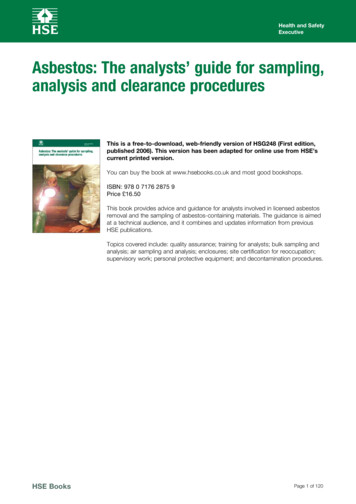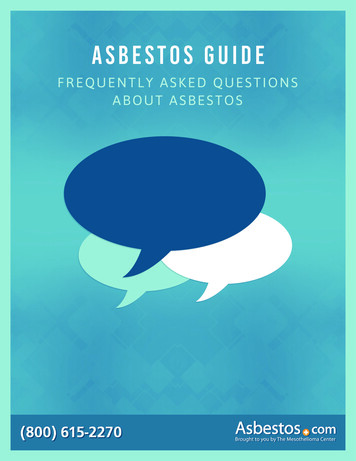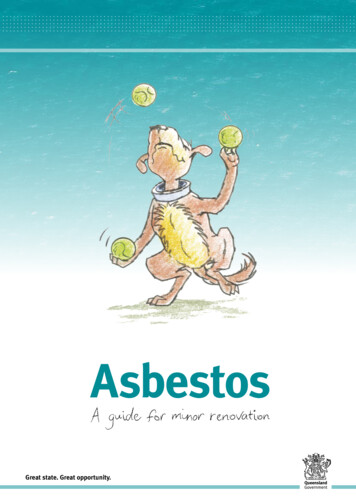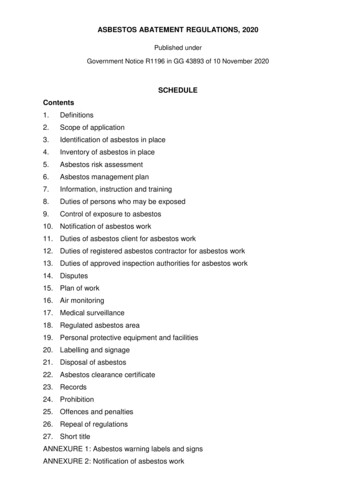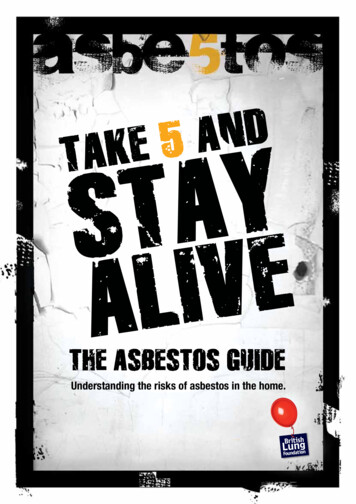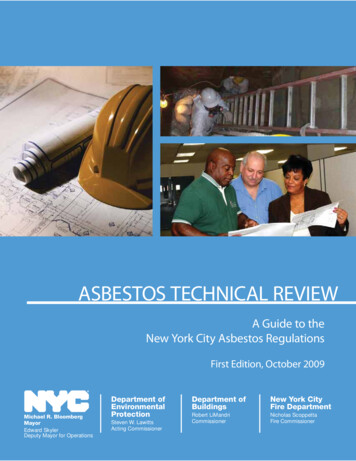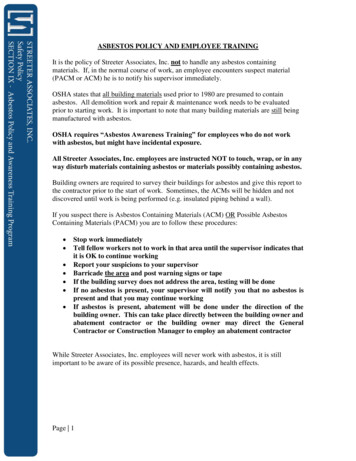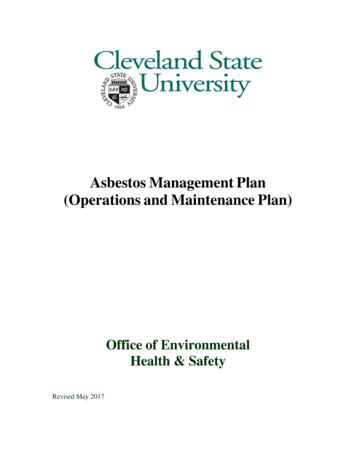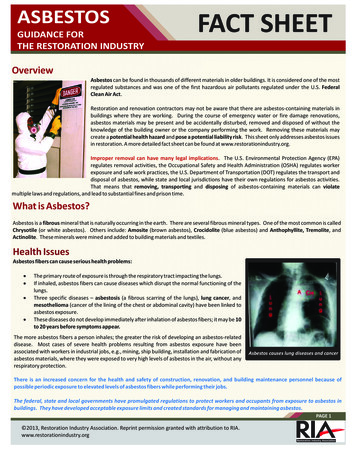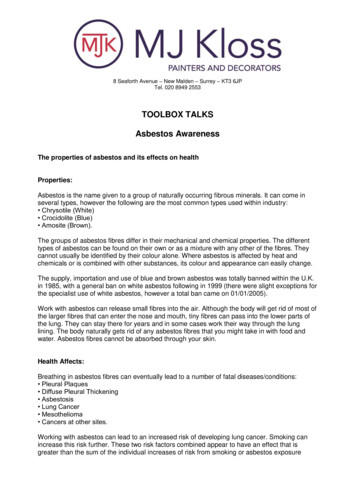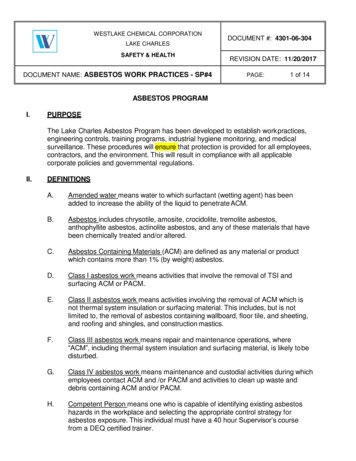
Transcription
WESTLAKE CHEMICAL CORPORATIONLAKE CHARLESSAFETY & HEALTHDOCUMENT NAME: ASBESTOS WORK PRACTICES - SP#4DOCUMENT #: 4301-06-304REVISION DATE: 11/20/2017PAGE:1 of 14ASBESTOS PROGRAMI.PURPOSEThe Lake Charles Asbestos Program has been developed to establish work practices,engineering controls, training programs, industrial hygiene monitoring, and medicalsurveillance. These procedures will ensure that protection is provided for all employees,contractors, and the environment. This will result in compliance with all applicablecorporate policies and governmental regulations.II.DEFINITIONSA.Amended water means water to which surfactant (wetting agent) has beenadded to increase the ability of the liquid to penetrate ACM.B.Asbestos includes chrysotile, amosite, crocidolite, tremolite asbestos,anthophyllite asbestos, actinolite asbestos, and any of these materials that havebeen chemically treated and/or altered.C.Asbestos Containing Materials (ACM) are defined as any material or productwhich contains more than 1% (by weight) asbestos.D.Class I asbestos work means activities that involve the removal of TSI andsurfacing ACM or PACM.E.Class II asbestos work means activities involving the removal of ACM which isnot thermal system insulation or surfacing material. This includes, but is notlimited to, the removal of asbestos containing wallboard, floor tile, and sheeting,and roofing and shingles, and construction mastics.F.Class III asbestos work means repair and maintenance operations, where“ACM”, including thermal system insulation and surfacing material, is likely to bedisturbed.G.Class IV asbestos work means maintenance and custodial activities during whichemployees contact ACM and /or PACM and activities to clean up waste anddebris containing ACM and/or PACM.H.Competent Person means one who is capable of identifying existing asbestoshazards in the workplace and selecting the appropriate control strategy forasbestos exposure. This individual must have a 40 hour Supervisor’s coursefrom a DEQ certified trainer.
WESTLAKE CHEMICAL CORPORATIONLAKE CHARLESSAFETY & HEALTHDOCUMENT NAME: ASBESTOS WORK PRACTICES - SP#4DOCUMENT #: 4301-06-304REVISION DATE: 11/20/2017PAGE:2 of 14I.Friable asbestos - These products can be easily crumbled using hand pressurealone to release airborne fibers of asbestos. Examples of friable ACM are: bulkasbestos, asbestos insulation, asbestos fireproofing, and asbestos cloth, rope orpaper.J.Non-Friable asbestos - These products contain asbestos, but it is tightly boundwithin some other material. They cannot be easily crumbled by hand pressurealone. Fibers will be released due to friction wear, cutting, scraping, or othermechanical action. Examples of non-friable ACM are: transite (asbestoscement) sheeting; asbestos gaskets and impregnated valve packing; asbestosbrake shoes and clutch linings; and asbestos impregnated floor tile.K.Employee Exposure means that exposure to airborne asbestos that would occurif the employee were not using respiratory equipment.L.Fiber means a particulate form of asbestos 5 micrometers or longer, with alength- to-diameter ratio of at least 3 to 1.M.High-efficiency Particulate air filter (HEPA) means a filter capable of trapping andretaining at least 99.97 percent of 0.3 micrometer diameter mono-disperseparticles.N.Presumed asbestos containing material (PACM) means thermal systeminsulation, sprayed on or troweled on surfacing material and debris in work areaswhere such material is present.O.Regulated Area means: an area established by the employer to demarcate areaswhere Class I, II, and/or III asbestos work is conducted, and any adjoining areawhere waste and debris from such asbestos work accumulate; and in areaswhere airborne concentrations of asbestos exceed, or there is reasonablepossibility they may exceed, the permissible exposure limit.P.Surfacing material means material that is sprayed, troweled on or otherwiseapplied to surfaces (such as acoustical plaster on ceilings and fireproofing onstructural members, or other materials on surfaces for acoustical, fireproofing,and other purposes).Q.Thermal System Insulation (TSI) means ACM applied to pipes, fittings, boilers,breeching, tanks, ducts, or other structural components to prevent heat loss orgain.
WESTLAKE CHEMICAL CORPORATIONLAKE CHARLESSAFETY & HEALTHDOCUMENT #: 4301-06-304REVISION DATE: 11/20/2017DOCUMENT NAME: ASBESTOS WORK PRACTICES - SP#4III.PAGE:3 of 14GENERAL:A.Sources of Potential Asbestos Exposure at Lake CharlesPotential asbestos exposure at Lake CharlesB.1.Electrolyzer-related maintenance workMaintenance jobs/work orders which are associated with Electrolyzerchlorine production. Some maintenance work involves equipment thatmay have remaining traces of asbestos contamination from the pastpractice of using asbestos slurry in Bipolar Electrolyzer Chlorineproduction.2.Maintenance work such as:a)Jobs involving friable asbestos or fireproofing materialsExample of this is stripping asbestos insulation or jacketing fromprocess equipment or piping, repair/removal of transite siding, willbe done by a certified Asbestos contractor.b)Non-friable asbestos containing materialExamples include asbestos gasket removal/replacement, removingcleaned valves, repairs in fluff room, service on equipment, jobsinvolving the old "black" Haveg Chemite pipe, and brake or clutchrepair work.c)Any activity/work performed near friable asbestos which couldcause accidental release or damage to ACM.Entering a vessel where PACM could be disturbed.d)Custodial/Maintenance activities in which work is done near ACMor PACM (janitorial/cleanup work).Controlled Areas1.Regulated AreasAll Class I, II, & III work shall be conducted within regulated areas. Allother operations covered by this procedure shall be conducted within aregulated area where airborne concentrations of asbestos exceed, orthere is reasonable probability they may exceed an IPEL.
WESTLAKE CHEMICAL CORPORATIONLAKE CHARLESSAFETY & HEALTHDOCUMENT NAME: ASBESTOS WORK PRACTICES - SP#42.DOCUMENT #: 4301-06-304REVISION DATE: 11/20/2017PAGE:4 of 14Non-friable AsbestosIn general, areas or work which involves non-friable asbestos materials ingood condition does not normally require the establishment of a controlledarea.However, work which will generate airborne fibers of asbestos must beperformed in a controlled manner.C.a)Where hand tools are used and the non-friable asbestos may bewetted (either with water or another agent) no special controls areneeded other than such housekeeping steps to preventcontamination of the work area.b)Where hand tools are used and the non-friable asbestos may notbe wetted (due to process, material, or other considerations) an"asbestos area" must be temporarily established and appropriateprotective steps taken.c)Whenever non-friable asbestos material must be machined, drilled,cut or ground using high-speed power equipment, a "regulatedarea" must be established unless special dust capturing localexhaust equipment is used. When local exhaust equipment isused, a "Regulated Area" must be temporarily established.Medical Surveillance ProgramAll persons who must work in a "Regulated Area" must be included in the LakeCharles Asbestos Medical Surveillance Program. This involves in-house preassignment and annual examinations for Westlake employees and certificationfrom contractors that their employees have had similar examinations. Details onexamination content and approval criteria are given in Section V.D.Air Monitoring for Asbestos and Exposure LimitsPersonnel and area air monitoring is conducted per the current Lake CharlesIndustrial Hygiene Sampling Strategy where potential asbestos exposure exists.Results of such monitoring will be communicated to affected employees andsupervisors.The OSHA exposure limit for asbestos is 0.1 fibers/ml air. OSHA also providesan "excursion limit" of 1.0 fibers/ml averaged over 30 minutes.
WESTLAKE CHEMICAL CORPORATIONLAKE CHARLESSAFETY & HEALTHDOCUMENT NAME: ASBESTOS WORK PRACTICES - SP#4E.DOCUMENT #: 4301-06-304REVISION DATE: 11/20/2017PAGE:5 of 14Regulations Concerning AsbestosThe Occupational Safety and Health Administration (OSHA) has established twoseparate regulations which address the use and handling of asbestos.CFR 1910.1001 - the general industry standard. This applies to our BipolarElectrolyzer Chlorine production operations and associated maintenance work,and by specific reference - brake/clutch repair activities.CFR 1926.1101 - the construction industry standard. This standard applies toall other jobs dealing with asbestos or asbestos containing materials, includingremoval of friable asbestos materials and insulation, transite siding, andasbestos cement piping, and gaskets.Copies of both OSHA standards are available for review from your Area SafetyRepresentative or from the Plant Industrial Hygienist.Finally, the U.S. EPA and LA. DEQ also have a number of regulationsconcerning asbestos. Refer to Section IX or contact Environmental Departmentfor details.F.G.Lake Charles Policy1.Asbestos or asbestos containing materials (ACM) will not be purchasedfor new installation at Lake Charles. Engineering specifications existwhich prohibit the use of asbestos in any form as an insulation material.Exceptions to this must be co-approved, in advance, by the Manager,Engineering & Maintenance and the Manager, Safety & Health. Westlakewill not perform any Class I or II asbestos work. All Class I or II asbestoswork will be contracted out to a certified contractor.2.Records of asbestos abatement projects including: abatement projectdesign records, asbestos air monitoring results, post-abatement photos,applicable medical records, disposal records and training records shall bemaintained.Identification of AsbestosAll insulation, pipe covering, non-steel pipe, and gaskets must be presumed tobe asbestos, unless verified through a legitimate source. Visual determination isnot allowed. Sources include testing, records showing material of construction,existing labeling, or records of previous scope of work identifying the material inquestion.1.Asbestos testinga)A bulk sample can be obtained for identification. The areasupervisor where the material is located will contact eitherIndustrial Hygiene (IH) or the Field Engineer trained as competent
WESTLAKE CHEMICAL CORPORATIONLAKE CHARLESSAFETY & HEALTHDOCUMENT NAME: ASBESTOS WORK PRACTICES - SP#4b)2.3.DOCUMENT #: 4301-06-304REVISION DATE: 11/20/2017PAGE:6 of 14person to arrange for an LDEQ licensed asbestos inspector toobtain a bulk sample. Work will proceed based on the results ofthat sample.It will be the responsibility of the competent person that requestedthe bulk sample to label positively identified asbestos material.This can be done by stenciling ACM in red. If the material is slatedfor immediate removal/abatement using red spray paint to mark thepositively identified material as ACM would suffice.The material may be assumed to be ACM and treated as such in lieu ofbulk sampling. Contact either IH or designated competent person toproceed.Labeling:a)When a section of asbestos containing insulation has beenremoved and replaced with non asbestos insulation, color codedbands shall be used to identify ACM and non-ACM. At a minimum,the non-ACM section shall have blue colored bands placed on theends of the section so that it is known that insulation between thetwo blue bands is non-asbestos. It is acceptable to place bluebanding on the entire abated section. Red colored bands shall beplaced adjacent to the end blue bands on the ACM side so that itwill be known where the identified ACM begins.b)When banding is not appropriate to label material, stencils may beused. Use red to stencil ACM and blue to stencil non-ACM.
WESTLAKE CHEMICAL CORPORATIONLAKE CHARLESSAFETY & HEALTHDOCUMENT #: 4301-06-304REVISION DATE: 11/20/2017DOCUMENT NAME: ASBESTOS WORK PRACTICES - SP#4H.PAGE:7 of 14Job Planning and Responsibilities1.2.The owner/planner of area where ACM is located shall:a)Review the job to determine if the work falls within the generalindustry or construction scope. The competent person shall beconsulted in making the determination.b)Methods of inspection, sample collection and sample analysis shallbe based on the predetermined job scope set forth by the jobowner/planner.c)Contact the competent person for their area (see Section III.H.2) atleast 24 hours in advance to supervise the job.d)Notify and communicate to affected personnel the nature andextent of work to be performed including work areas to berestricted and approximate length of time of job.e)If the job is contracted out, contact the environmental group per theguidelines given in Section IX of this policy. There may benotification requirements. Class III jobs are estimated on an annualbasis and do not require a case-by-case notification.f)If job is postponed or cancelled, any friable ACM exposed becauseof job preparation or testing shall be either encapsulated orremoved.Removal/Renovation of ACM – Competent PersonAll asbestos/assumed asbestos removal/renovation jobs must besupervised by an Westlake asbestos competent field engineer trained andcertified by the State of Louisiana.Contractor removal/renovation jobs will be supervised by their owncompetent persons with Westlake competent person(s) (Trained fieldengineering personnel) as coordinators. Field engineering asbestoschecklist is EDM 3200-PRO-009.3.All removal/renovation work involving friable ACM shall be reported to theWestlake competent person at least 24 hours in advance. The competentperson shall:a)Coordinate and supervise the removal/renovation job per all
WESTLAKE CHEMICAL CORPORATIONLAKE CHARLESSAFETY & HEALTHDOCUMENT #: 4301-06-304REVISION DATE: 11/20/2017DOCUMENT NAME: ASBESTOS WORK PRACTICES - SP#4PAGE:8 of 14applicable regulations and corporate policy.IV.b)Complete asbestos removal safe work practice and disposalchecklist for each job and forward to environmental secretary within2 days of completing job.c)All area air monitoring data collected by Westlake and abatementcontractors during asbestos abatement work shall be entered intothe Westlake IH management system referencing the asbestosabatement project by name or project number, in addition to beingpart of the project record.d)Visual inspections shall be performed prior to re-occupying allasbestos abatement areas to assure that dust has been cleanedfrom surfaces.e)If the job includes abatement of insulation verify that the area wasbanded with the appropriate band and stenciled.f)Photographs shall be taken after planned asbestos abatementproject completion to document that all work was performed inaccordance with removal specifications and that the space wasacceptable for occupancy post removal. Photographs do nothave to be taken of small scale asbestos abatement projects.Refer to the corporate policy for definition of “small scale”.COMMUNICATIONS OF HAZARDS TO EMPLOYEESA.Warning Signs and Barricades1.Posting - Warning signs must be posted at the entrance to and perimeterof all controlled or regulated areas. Areas which are not defined by wallsor other permanent barriers are to be barricaded using yellow barricadetape with an asbestos warning imprinted.2.Specification - Warning signs shall be in the standard OSHA "danger"format and read:DANGERASBESTOSMAY CAUSE CANCERCAUSES DAMAGE TO LUNGSAUTHORIZED PERSONNEL ONLY
WESTLAKE CHEMICAL CORPORATIONLAKE CHARLESDOCUMENT #: 4301-06-304SAFETY & HEALTHDOCUMENT NAME: ASBESTOS WORK PRACTICES - SP#4REVISION DATE: 11/20/2017PAGE:9 of 14In addition, where the use of respirators and protective clothing is requiredin the regulated area, the warning sign shall include:WEAR RESPIRATORY PROTECTION AND PROTECTIVE CLOTHINGIN THIS AREAB.Warning Labels1.Labeling - Warning labels shall be affixed to or imprinted on all containers,bags, etc., which contain asbestos, asbestos slurry, scrap, or asbestoscontaining material, debris, scrap, etc.2.Specification - Labels may be in any format provided the followinginformation is included:DANGERCONTAINS ASBESTOS FIBERSMAY CAUSE CANCERCAUSES DAMAGE TO LUNGSDO NOT BREATHE DUSTAVOID CREATING DUSTWESTLAKE CORPORATION- LAKE CHARLESC.Employee Training1.Minimum Required TrainingAll employees that are exposed or potentially exposed to asbestos willreceive annual training on:a)b)c)d)e)f)g)2.Lake Charles Asbestos ProgramHealth Hazards of AsbestosRestricted Areas and JobsitesWork practices for ACMRecognition of ACM or PACMOSHA regulationsSmoking Cessation program availabilityBiPolar Electrolyzer Operations & Related MaintenanceAll employees (and their supervisors) potentially exposed to asbestos aspart of the electrolyzer diaphragm operation or related asbestosmaintenance work with contaminated material will receive initial andannual training. This training will cover:
WESTLAKE CHEMICAL CORPORATIONLAKE CHARLESSAFETY & HEALTHDOCUMENT NAME: ASBESTOS WORK PRACTICES - SP#4a)b)c)d)e)f)3.REVISION DATE: 11/20/2017PAGE:10 of 14All minimum required training listed above,Required personal protective equipment,Proper operation of engineering controls,Required housekeeping procedures,Description of the plant Medical Surveillance Program,Work practices necessary for safe handling of asbestos.Custodial Workersa)V.DOCUMENT #: 4301-06-304All custodial workers will be given 2 hour awareness level trainingthat will consist of:(1)All minimum required training listed above.(2)Required personal protective equipment(3)Description of Medical Surveillance Program.(4)Required work practices.MEDICAL SURVEILLANCE PROGRAMA.Employees IncludedThe Medical Department maintains a roster of all Lake Charles South employeeswho must work in a Regulated Area and are medically approved for such work.Contractor personnel are responsible for maintaining their own programs andrecords and are subject to program audits by Westlake.Supervisors must notify the Plant Nurse and Industrial Hygiene in advance ofany personnel changes which will affect this list. Employees who are notpresently participating in the asbestos Medical Surveillance Program must beexamined and approved prior to their new assignment.Individuals who terminate their employment for any reason will also be offered anexit examination. Such employees may be eligible for continued healthsurveillance under the Westlake Health Care Policy. Contact the MedicalDepartment for further details.B.Content of Asbestos ExaminationEach employee will be examined by the Plant Physician prior to assignment andannually thereafter. The examination will include:
WESTLAKE CHEMICAL CORPORATIONLAKE CHARLESSAFETY & HEALTHDOCUMENT NAME: ASBESTOS WORK PRACTICES - SP#41.2.3.4.5.C.DOCUMENT #: 4301-06-304REVISION DATE: 11/20/2017PAGE:11 of 14Medical and Work History Questionnaire,Pulmonary Function Tests (FEV1 and FVC),Chest x-rays (with interpretation by a "B-reader" certified radiologist), perthe schedule given in 1910.1001(l)(3) - Table 2.Physical examination by the physician,Any additional testing deemed necessary by the plant physician.Medical ApprovalCriteria - The Plant Physician will determine, based upon test and examinationresults, in his opinion whether an employee has any detected medicalcondition(s) that would place the employee at an increased risk of healthimpairment from exposure to asbestos (or asbestos containing materials). In theevent of such determination - the employee will not be approved for asbestoswork.Employee Notification - The Plant Physician will inform each employee of theresults of his/her examination and the presence of any medical condition whichmay be related to asbestos exposure. The employee will receive a copy of thewritten physician’s opinion/approval within 30 days of the examination.Supervisor Notification - The employee's supervisor will be notified by theMedical Department in writing of any asbestos related work restrictions.Confidentiality - The Plant Physician will not reveal, in any written opinion givento the employer, any specific findings or diagnoses unrelated to occupationalexposure to asbestos or other workplace hazards.VI.PERSONAL PROTECTIVE EQUIPMENT (PPE)While engineering controls and work practices generally reduce asbestos exposurelevels, personal protective equipment is the final barrier against asbestos exposure.A.Respiratory Protection1.All provisions of the Lake Charles Respiratory Protection Program mustbe observed. Selection of the level of equipment required is based onthe table below.a)AsbestosFiber Count RespiratorUnknown 100Pressure-demand airline w/escape provisionsPressure-demand airline w/escape provisions
WESTLAKE CHEMICAL CORPORATIONLAKE CHARLESSAFETY & HEALTHDOCUMENT NAME: ASBESTOS WORK PRACTICES - SP#45 to 1000.1 to 50.01 to 0.1B.REVISION DATE: 11/20/2017PAGE:12 of 14Pressure-demand airlineFull-face mask w/asbestos or HEPA filtersHalf-mask w/asbestos or HEPA cartridgesProtective Clothing1.2.3.VII.DOCUMENT #: 4301-06-304Disposable coveralls w/hood & feet - Tyvek or similar impervious material.Rubber boots (so that any contamination may be rinsed off.)Gloves - (any type is permissible, but must be disposed of after use).PERSONAL HYGIENEA.Decontamination1.Employees required to enter regulated areas must wear full protectiveclothing (not over street clothes). Change rooms with separate "clean"and "dirty" locker areas must be used. If change and shower room (with"dirty" and "clean" locker areas) are not adjacent to the work site, then twosets of coveralls must be used (one worn over the other). When leavingthe regulated Area, decontamination is to be performed as follows:a)Vacuum off protective clothing and respirator. Remove outercoveralls and respirator. Proceed to a shower facility (a designatedshower facility is not required). Shower and change to streetclothing.b)If a designated shower facility is adjacent to the regulated area,vacuum off protective clothing, proceed to dirty room, removeprotective clothing, shower (with respirator in place) and changeinto street clothes in the clean room.*All employees working in a regulated area shall have facilities and time availablefor showering at the end of a work shift.2.Food or Tobacco Consumptiona)b)c)Employees may not eat, drink, smoke, chew gum or tobacco.The employee must exit the regulated area - after properdecontamination steps are taken - and wash their hands and faceprior to eating, drinking, smoking, etc.No employee may enter a lunchroom with contaminated equipmentor clothing.
WESTLAKE CHEMICAL CORPORATIONLAKE CHARLESSAFETY & HEALTHDOCUMENT NAME: ASBESTOS WORK PRACTICES - SP#4VIII.REVISION DATE: 11/20/2017PAGE:13 of 14HOUSEKEEPINGA.All surfaces will be maintained free of any accumulation of asbestos or wastescontaining asbestos.B.All spills or sudden releases of asbestos will be cleaned up immediately usingwet methods or a HEPA vacuum.C.Compressed air shall not be used to clean surfaces or clothing contaminatedwith asbestos.All vacuums used for cleaning must be equipped with a HEPA exhaust filter.Special care must be taken when emptying such equipment to avoid re-entry ofasbestos fibers to the workroom air.Vacuuming and/or wet wiping is the preferred method of cleaning. Shoveling,dry sweeping without a HEPA vacuum, or other dry methods of cleaning are notpermitted.D.E.IX.DOCUMENT #: 4301-06-304ASBESTOS NOTIFICATION GUIDELINES & DISPOSALA.Contact the Environmental Department (See 35-EAIR-PRO-042) for guidelinesand forms on Asbestos Notifications for the following operations:1.Chlorine Production (process wastes)2.Non-scheduled operations (Individual asbestos insulation removal jobs ofless than 1 cubic yard).3.Planned Operations (Asbestos insulation removal equal to or more than 1cubic yard). Environmental must be notified at least 10 days in advanceon all jobs 1 cubic yard4.Emergency Operation (Caused by sudden, unexpected event andinvolves asbestos removal equal to or more than 1 cubic yard).Environmental must be immediately on all jobs 1 cubic yard (LDEQrequirement)Items 3 and 4 above require a separate Asbestos Disposal Verification Form.B.Louisiana Department of Environmental Quality regulations currently requireasbestos disposal at a site approved for asbestos and industrial solid waste.Contact the Environmental Department for guidelines on proper disposal.
WESTLAKE CHEMICAL CORPORATIONLAKE CHARLESSAFETY & HEALTHDOCUMENT NAME: ASBESTOS WORK PRACTICES - SP#4X.DOCUMENT #: 4301-06-304REVISION DATE: 11/20/2017PAGE:14 of 14WORK PRACTICESA.B.Non-Friable Asbestos1.Many products within the Lake Charles Plant contain non-friable asbestosand do not pose any hazard under normal conditions. But any actionwhich causes fibers to be released does result in a potential hazard.General for handling a variety of non-friable asbestos items are givenbelow.2.The purchase of ACM gaskets has been phased out, but due to the factthat there may be isolated cases where ACM gaskets are still in use, thefollowing work procedures on replacing ACM gaskets is included. Whenpiping and equipment is dismantled, the surfaces of the connection mustbe inspected for the presence of a gasket. If a gasket cannot be identifiedas non-asbestos (rubber, graphite, flexitalic) a certified asbestos inspectormust be called to sample and identify the gasket as asbestos or nonasbestos. A gasket identified as containing asbestos will be removed bythe asbestos abatement contractor.3.Jobs involving cutting or abrading the surface of Piping must consider thepossibility of asbestos piping. If the piping cannot be verified to be nonasbestos as in section III, it must be tested.Bi-Polar Electrolyzer Operations1.C.Work procedures for operations use of asbestos are extremely detailedand are covered in Plants A & C unit SOPs.Maintenance Work Associated with Electrolyzer Operations1.Cell elements or equipment associated with Electrolyzer Chlorineproduction are to be cleaned before being released for maintenance work.2.However, emergency repairs of contaminated equipment or tracecontamination of cell elements being worked on require certainprecautions to be followed. See Plants A & C Maintenance SMPs.
Examples of non-friable ACM are: transite (asbestos cement) sheeting; asbestos gaskets and impregnated valve packing; asbestos brake shoes and clutch linings; and asbestos impregnated floor tile. . involving the old "black" Haveg Chemite pipe, and brake orclutch repair work. c) Any activity/work performed near friable asbestos which could
